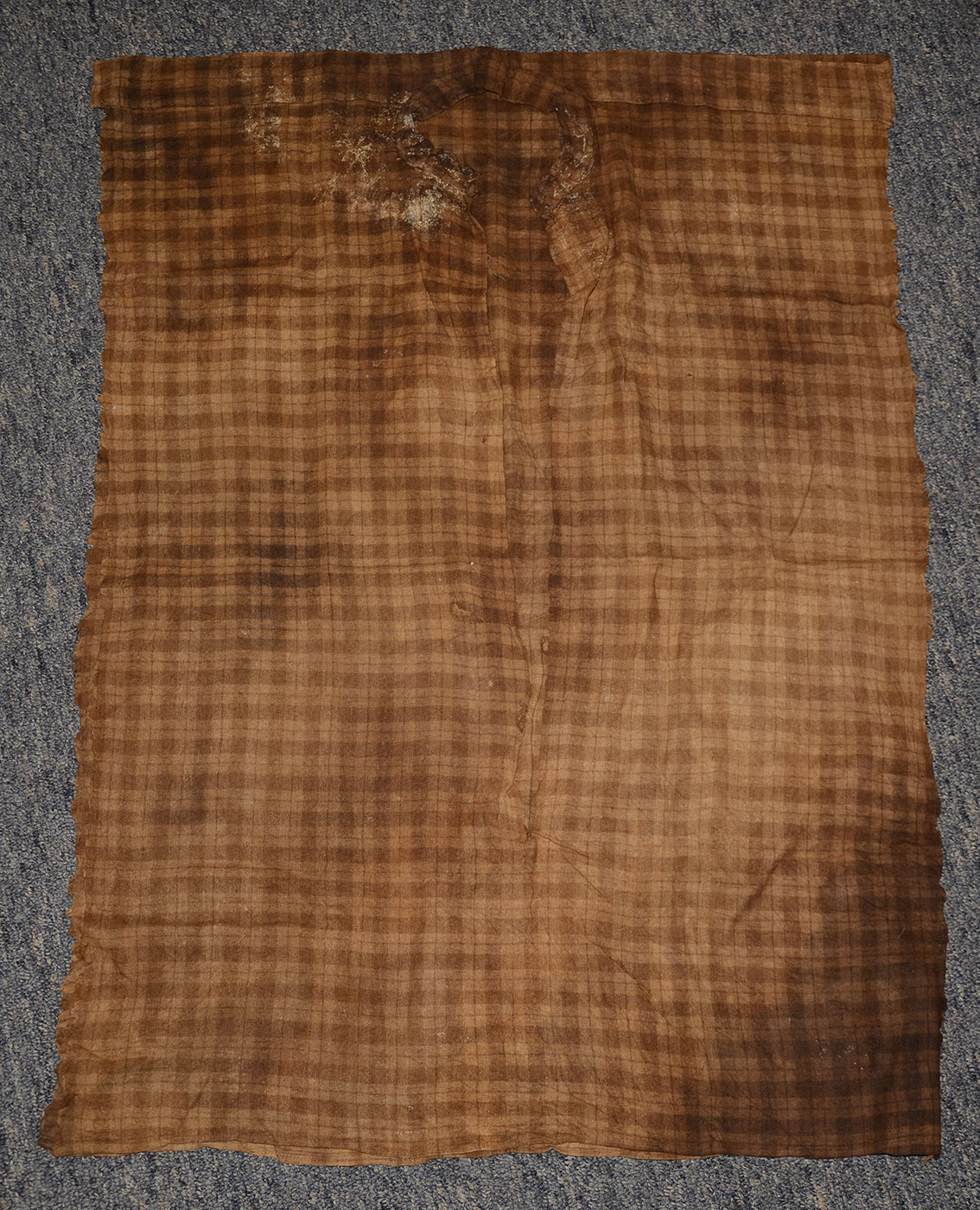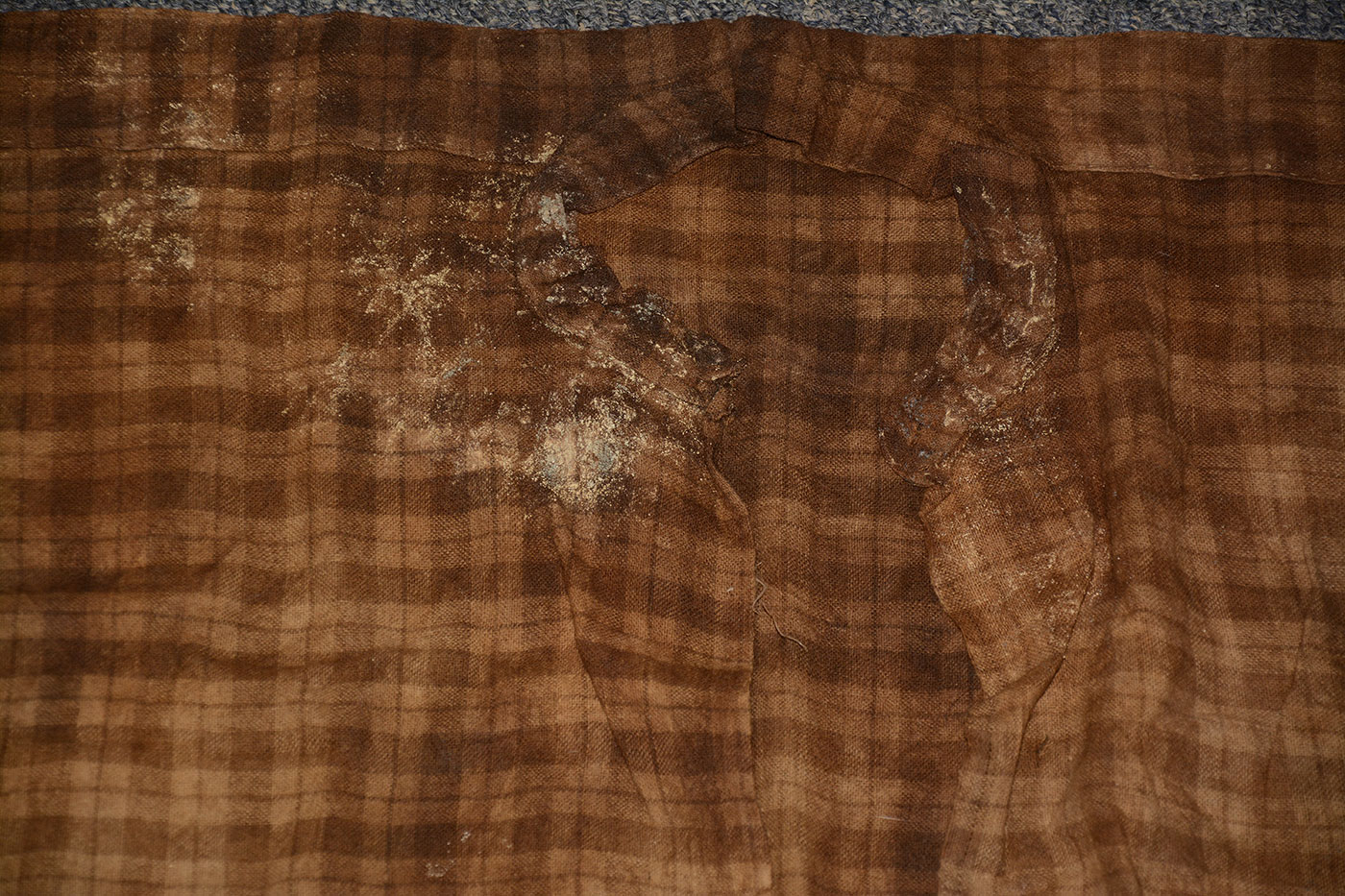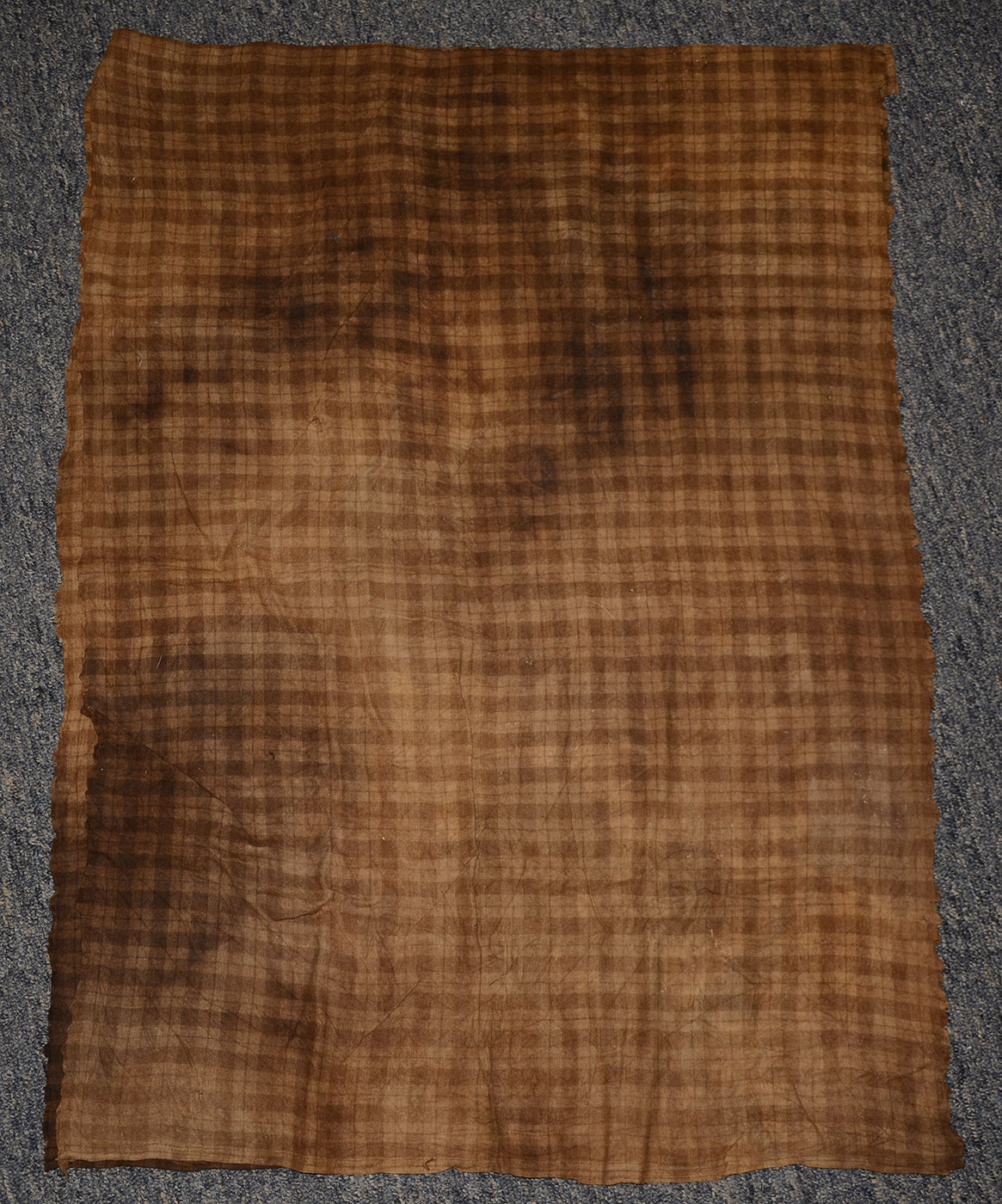site search
online catalog
CIVIL WAR ERA WORKSHIRT/SMOCK MADE FROM ALTERED SHIRT FORT PEMBINA

Hover to zoom



$1,850.00
Quantity Available: 1
Item Code: 1052-648
Shipping: Determined by Method & Location of buyer
To Order:
Call 717-334-0347,
Fax 717-334-5016, or E-mail
This is a simple shirt altered by a soldier at a frontier US Army fort for wear as smock to shield his uniform while on a work or fatigue detail and comes from excavations at Fort Pembina, North Dakota, where soil conditions have yielded cloth and leather in remarkable states of preservation. The shirt may have been army issue, though now a brownish-olive green in color. The body is one-piece, about 22 inches across and 27 inches top to bottom on front and back. The collar may have been altered. It is folded to make two layers, stands a tad over 2 inches tall and extends about 1 ¼ inches beyond the breast opening of the shirt on either side, so that it would effectively overlap, though we see no buttonholes. Chances are this was intended to further protect a uniform or other clothing underneath by closing well around the neck. Stitching shows the shirt initially had an opening slit down the front about 10 inches long. A tear now lengthens that to 18 inches, but it looks intentional, to make it easier to put on over other clothing. We see no buttonholes along opening, but army shirts frequently had a single collar button serving to close them. The soldier also opened up the sides of the shirt, likely with the same intention of simply making it easier to put on, removing the sleeves at the same time. A seam extending up and over the shoulder seems to mark the placement of the sleeves.
The condition is good. The fabric is supple and holds together, though there are light colored stains on the front of the collar, lower front and upper back of the body. The rear also shows a tear down the middle, extending about 10 inches below the collar, though no fabric seems to be missing. The edge of the right shoulder has a tear running up and over it, creating a loose strip about 1 ¼ inch wide and 12 inches long running up front edge, with a short matching piece on the back. No fabric seems to be missing, so it could be mended or lined up when displayed flat. There are a number of other small holes or wear spots. On the whole, however, the shirt displays well and is an interesting piece, the sort of thing that was used as long as it could be and then reused to protect other garments on work or fatigue details. This is not the sort of thing that would be preserved by the soldier or his family as a memento. His dress unform would certainly have been more impressive and socially acceptable, even if he spent a lot more time on fatigue duty than he did on dress parade.
Fort Pembina, situated in the Red River Valley in North Dakota near the Canadian border, was established in 1870 and in operation until 1895. Trading posts existed earlier in the area as part of the fur trade, and the first U.S. military post there was temporary- manned by a detachment of Minnesota troops in 1863-1864 following the 1862 Sioux uprising. In March 1870 a new fort was established south of the Pembina River and about 200 yards west of the Red River, completed by July and named in honor of Gen. George H. Thomas. The name was changed to Fort Pembina in September and the initial garrison consisted of two companies of the 20th US Infantry. Their main duty was to provide security for settlers worried about Sioux returning south from Canada, but the troops were more occupied with escorting boundary surveys along the Canadian border and preventing Fenian raids heading north into Canada.
The fort included enlistedmen’s barracks, officers’ quarters, guard house, ordnance storehouse, company kitchen, root house, laundress’s quarters, quarters for civilian employees, hospital and hospital servant’s house, a barn for the “hospital cow,” quartermaster and commissary offices and storehouse, stables, wagon shed, etc. The garrison reached peak strength in 1878 af 200, but the average was about 125 enlisted men and 8 officers. An October 1885 return listed 97 men, 2 field pieces, 1 mountain howitzer, 100 rifles, 19 pistols, 23 mules, and 9 wagons. By 1890 the post had just 23 men, and after an 1895 fire destroyed some 19 buildings it was decided to abandon the fort rather than rebuild, the last detachment left in September. The property was turned over to the Interior Department and later sold in 1902.
This is a scarce piece, emphatically showing the less glamorous side of army life- not the stuff of recruiting posters or treasured family photographs, something more akin to the clothing and gear shown in Stanley Morrow’s 1876 photos of Crooks “starvation march,” even if those troops were on active campaign and this was more likely the result of the daily drudgery of garrison duty on the frontier. [sr] [ph:L]
~~~~~~~~~~~~~~~~~~~~~~~~~~~~~~~~~~~
THIS ITEM, AS WITH ALL OTHER ITEMS AVAILABLE ON OUR WEB SITE,
MAY BE PURCHASED THROUGH OUR LAYAWAY PROGRAM.
CLICK HERE FOR OUR POLICIES AND TERMS.
THANK YOU!
Inquire About CIVIL WAR ERA WORKSHIRT/SMOCK MADE FROM ALTERED SHIRT FORT PEMBINA
Most Popular
Historical Firearms Stolen From The National Civil War Museum In Harrisburg, Pa »
Theft From Gravesite Of Gen. John Reynolds »
Selection Of Unframed Prints By Don Troiani »
Fine Condition Brass Infantry Bugle Insignia »
Large English Bowie Knife With Sheath 1870’S – 1880’S »
Imported (Clauberg) Us Model 1860 Light Cavalry Officer's Saber »
featured item
UNION CAVALRY GENERAL WILLIAM WELLS’ FIELD BLOUSE: MEDAL OF HONOR FOR GETTYSBURG WHERE HE RODE IN THE LEAD OF FARNSWORTH’S CHARGE; BRIGADE COMMANDER UNDER CUSTER; BLOUSE ACTUALLY WORN IN ONE OF HIS PHOTOS
This coat is the epitome of a Civil War Union general’s field uniform, a blouse following the popular sack coat pattern of the period, looking somewhat like an enlisted man’s fatigue blouse and suitable for campaign wear, but with a double row of… (1179-281). Learn More »


